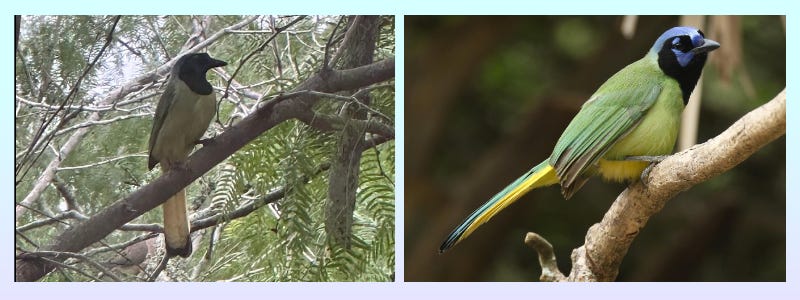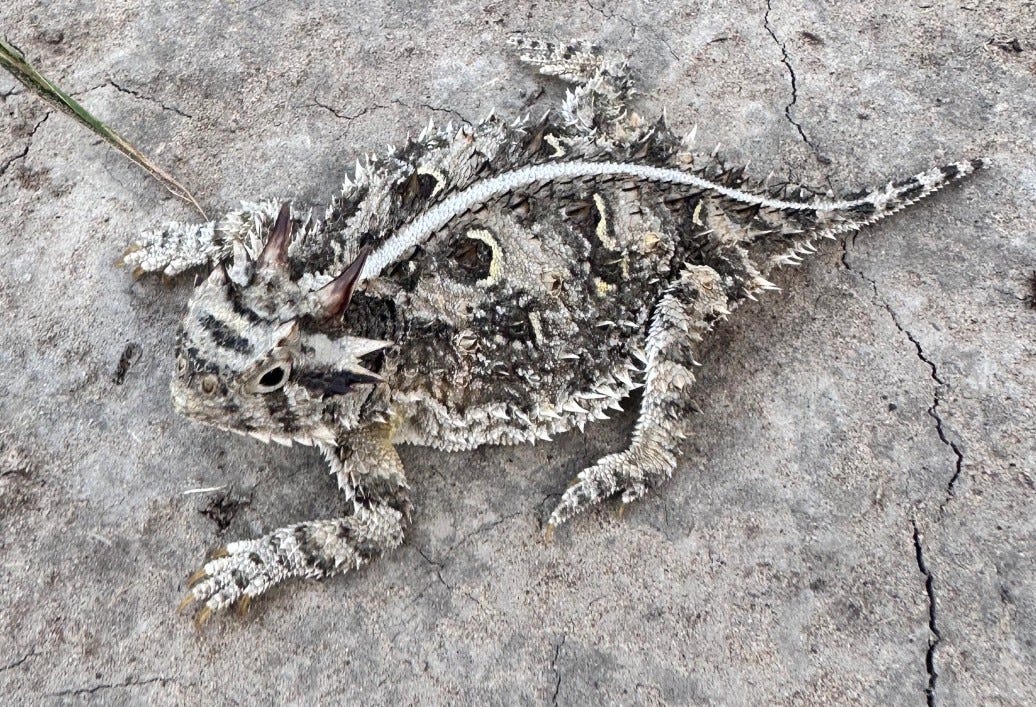First, exciting news: I am working on a magazine article! I’ve been pitching the publication various “critter” stories for a while now, and am so happy this one was greenlit!
I don’t want to get too specific about the article—no spoiler alerts!—but as part of it, last weekend I traveled to the Cactus Creek Ranch in deep South Texas.
It. Was. A. Dream. Assignment.
First, the ranch owner, Mary Jo, blew my mind. She’s a total badass conservationist and outdoorswoman and fellow cactus lover. I mean, y’all, check out the slogan for her ranch:
Yep, you read that right: Life is prickly. Bloom anyway.
WHAT!? That is like the whole point of my memoir-in-progress!
The ranch is 400 acres, and it’s incredible. Mary Jo has spent 30 years restoring it to native habitat. And like the Field of Dreams, if you build it, they will come. “They” as in OMGCRITTERS!!#$$%^!!
For the purpose of my upcoming article, I’m leaving out one very important critter in this newsletter. But here’s a quick meet-and-greet of some other VICs…

First up, the stunning green jay, whose northern range just barely extends into South Texas. Typical of a corvid, it is highly intelligent, yet the green jay dresses up like it’s headed to Carnaval.
That bird alone bowled me over. But I also got to see the iconic Texas horned lizard for the first time!
Because the Texas horned lizard has been in serious decline for decades, Texas Parks & Wildlife and several zoo partners are working aggressively to replenish them in the wild. (You can help by not using ant poison.)
Mary Jo painstakingly cares for her resident horned lizards, even setting out protective wooden shelters over the top of red ant mounds, so the lizards can eat their favorite food without fear of a raptor or other predator swooping down and carrying them away.
As fierce as they look, horned lizards are harmless. But that’s not the case for another reptile we spotted: The Western diamondback rattlesnake (one of TEN rattlesnake species in Texas).
Damn, this boi (or girl) was chonky. But fortunately it was slithering away from us, whew:
Did I mention the snake was maybe ten feet from my cabin door? And the molt maybe five? As if the snake chaps hanging up in the cabin weren’t hint enough, I sure as hell started looking both ways before crossing every trail.
Not to be outdone, the local fiddler crabs brought their A-game. Unlike the ghost crabs that populate Texas beaches, the fiddlers are easy to spot and pick up. Then they try their best to intimidate you with their giant claw.
Circling back to birds, I was charmed to pieces by the plethora of bobwhite quail, which dart around the ranch seemingly unfazed by the rattlesnakes and Harris hawks. Their little coos of bob-white, bob-white let you know they are near, even if they blend into the brush.
A shout-out also goes to the great kiskadees and hungry golden-fronted woodpeckers who wouldn’t pose for the camera, and the millennial pink roseate spoonbill feather we found on the ground.

Last but not least, I “assisted” local citizen scientist, Mark Conway, who is authorized under federal permitting to band black-crested titmouse fledglings. My job was to gently hold the babies in a fabric bag after they were banded, and then keep my hand over the nest box while we placed them back inside. His job was to do everything else.
In the U.S., black-crested titmouse are found in Texas and a wee bit of Oklahoma. To help track their health, Mark and other banders keep copious data on various clutches around the Rio Grande Valley. (Like Mary Jo, he is a local wildlife hero.)
Amazingly, this is just a smattering of the wildlife I spent time with this weekend. There also was the pack rats (yes, literal pack rats), hogs, white-tailed deer, gigantic exotic nilgai (which I also consumed in burger form), plants, bugs (um, the spiders were…copious?), and of course, my VIC.
Look, I know that hanging out with snakes and spiders is not everyone’s idea of a “wild” weekend. But for me, being surrounded by biodiversity—even of the pit viper variety—is restorative to my mental health. Too much of my one wild and precious life is spent in strip malls, on concrete, in office chairs, on highways, listening to artificial noise and breathing stale air.
Mary Jo’s hard work is proof you don’t need dramatic snowy mountains, big clear streams, or towering trees to reconnect with nature. The less showy South Texas thornscrub can hold its own.











This is such an interesting read, Joy. I am fascinated by your picture of the coastal prairie and then by its inhabitants as I live in another kind of prairie here with some very different creatures. Congratulations on the article!
This was so fascinating - and the pink feather! Congratulations on the upcoming article, that's exciting.